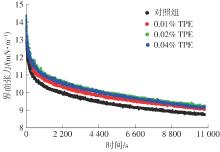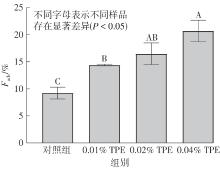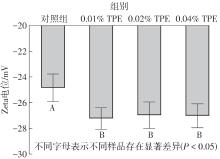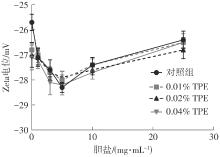Journal of South China University of Technology(Natural Science Edition) ›› 2024, Vol. 52 ›› Issue (4): 26-32.doi: 10.12141/j.issn.1000-565X.230325
• Food Science & Technology • Previous Articles Next Articles
Effect of Tea Polyphenols on Soy Protein Isolate-Stabilized Emulsions and Interfacial Protein Displacement by Bile Salts
GE Ge1,2 LIN Li1 ZHENG Jiabao2 SUN Weizheng2
- 1.Beijing Institute of Food Inspection and Research (Beijing Municipal Center for Food Safety Monitoring and Risk Assessment),Beijing 100094,China
2.School of Food Science and Engineering,South China University of Technology,Guangzhou 510640,Guangdong,China
-
Received:2023-05-15Online:2024-04-25Published:2023-07-12 -
Contact:孙为正(1983-),男,博士,教授,主要从事蛋白质化学与营养研究。 E-mail:fewzhsun@scut.edu.cn -
About author:葛鸽(1992-),女,博士,工程师,主要从事蛋白质化学与营养研究。E-mail:gege131700@163.com -
Supported by:the General Program of the Natural Science Foundation of Guangdong Province(2021A1515010638)
CLC Number:
Cite this article
GE Ge, LIN Li, ZHENG Jiabao, et al. Effect of Tea Polyphenols on Soy Protein Isolate-Stabilized Emulsions and Interfacial Protein Displacement by Bile Salts[J]. Journal of South China University of Technology(Natural Science Edition), 2024, 52(4): 26-32.
share this article
| 1 | NISHINARI K, FANG Y, GUO S,et al .Soy proteins:a review on composition,aggregation and emulsification[J].Food Hydrocolloids,2014,39:301-318. |
| 2 | TANG C-H .Nanostructured soy proteins:fabrication and applications as delivery systems for bioactives (a review)[J].Food Hydrocolloids, 2019,91:92-116. |
| 3 | JAMBRAK A R, LELAS V, MASON T J,et al .Physical properties of ultrasound treated soy proteins[J].Journal of Food Engineering,2009,93(4):386-393. |
| 4 | CHEN N, ZHAO Q, SUN W,et al .Effects of malondialdehyde modification on the in vitro digestibility of soy protein isolate[J].Journal of Agricultural and Food Chemistry,2013,61(49):12139-12145. |
| 5 | DELFANIAN M, RAZAVI S M A, HADDAD-KHODAPARAST M H,et al .Influence of main emulsion components on the physicochemical and functional properties of W/O/W nano-emulsion:effect of polyphenols,Hi-Cap,basil seed gum,soy and whey protein isolates[J].Food Research International,2018,108:136-143. |
| 6 | LIU F, MA C, ZHANG R,et al .Controlling the potential gastrointestinal fate of beta-carotene emulsions using interfacial engineering:impact of coating lipid droplets with polyphenol-protein-carbohydrate conjugate[J].Food Chemistry,2017,221:395-403. |
| 7 | GOLDING M, WOOSTER T J .The influence of emulsion structure and stability on lipid digestion[J].Current Opinion in Colloid & Interface Science,2010,15(1/2):90-101. |
| 8 | MALDONADO-VALDERRAMA J, WILDE P,MACIER- ZANKA A,et al .The role of bile salts in digestion[J].Advances in Colloid and Interface Science,2011,165(1):36-46. |
| 9 | SARKAR A, ZHANG S, HOLMES M,et al .Colloidal aspects of digestion of Pickering emulsions:experiments and theoretical models of lipid digestion kinetics[J].Advances in Colloid and Interface Science,2019,263:195-211. |
| 10 | SARKAR A, HORNE D S, SINGH H .Interactions of milk protein-stabilized oil-in-water emulsions with bile salts in a simulated upper intestinal model[J].Food Hydrocolloids,2010,24(2/3):142-151. |
| 11 | CAO Y, AI N, TRUE A D,et al .Effects of (-)-epigallocatechin-3-gallate incorporation on the physicochemical and oxidative stability of myofibrillar protein-soybean oil emulsions[J].Food Chemistry,2018,245:439-445. |
| 12 | TIAN L, KEJING Y, ZHANG S,et al .Impact of tea polyphenols on the stability of oil-in-water emulsions coated by whey proteins[J].Food Chemistry,2021,343:128448/1-9. |
| 13 | ZHAO M, JIAO M, ZHOU F,et al .Interaction of beta-conglycinin with catechin-impact on physical and oxidative stability of safflower oil-in-water emulsion[J].Food Chemistry,2018,268:315-323. |
| 14 | TAO F, JIANG H, CHEN W,et al .Covalent modification of soy protein isolate by (-)-epigallocatechin-3-gallate:effects on structural and emulsifying properties[J].Journal of the Science of Food and Agriculture,2018,98(15):5683-5689. |
| 15 | JU M, ZHU G, HUANG G,et al .A novel pickering emulsion produced using soy protein-anthocyanin complex nanoparticles[J].Food Hydrocolloids,2020,99:105329/1-8. |
| 16 | 沈鹏辉 .基于可控酶解制备大豆蛋白纳米颗粒及其乳液脂质消化的调控研究[D].广州:华南理工大学,2020. |
| 17 | 沈鹏辉,樊诗堃,赵谋明,等 .氧化对大豆蛋白结构、乳液稳定性及消化特性的影响[J].食品科学,2019,40(14):7-14 |
| SHEN Penghui, FAN Shikun, ZHAO Mouming,et al .Influence of oxidation on soy protein structure,emulsion stability and lipid digestion[J].Food Science,2019,40(14):7-14. | |
| 18 | LESMES U, BAUDOT P, MCCLEMENTS D J .Impact of interfacial composition on physical stability and in vitro lipase digestibility of triacylglycerol oil droplets coated with lactoferrin and/or caseinate[J].Journal of Agricultural and Food Chemistry,2010,58(13):7962-7969. |
| 19 | CHEN Y, HU J, YI X,et al .Interactions and emulsifying properties of ovalbumin with tannic acid[J].LWT-Food Science and Technology,2018,95:282-288. |
| 20 | ZHAN F, LI J, WANG Y,et al .Bulk,foam,and interfacial properties of tannic acid/sodium caseinate nanocomplexes[J].Journal of Agricultural and Food Chemistry,2018,66(26):6832-6839. |
| 21 | SUN W, ZHOU F, SUN D-W,et al .Effect of oxidation on the emulsifying properties of myofibrillar proteins[J].Food and Bioprocess Technology,2012,6(7):1703-1712. |
| 22 | REN C, XIONG W, PENG D,et al .Effects of thermal sterilization on soy protein isolate/polyphenol complexes:aspects of structure,in vitro digestibility and antioxidant activity[J].Food Research International,2018,112:284-290. |
| 23 | LI Q, HE Q, XU M,et al .Food-grade emulsions and emulsion gels prepared by soy protein-pectin complex nanoparticles and glycyrrhizic acid nanofibrils[J].Journal of Agricultural and Food Chemistry,2020,68(4):1051-1063. |
| 24 | DONG Y, LAN T, HUANG G,et al .Development and characterization of nanoparticles formed by soy peptide aggregate and epigallocatechin-3-gallate as an emulsion stabilizer[J].LWT-Food Science and Technology,2021,152:112385/1-9. |
| 25 | WALSTRA P .Dispersed systems:basic considerations[M]∥ FENNEMA O R.Food chemistry.3rd ed .New York:Marcel Dekker Inc.,1996:95-155. |
| 26 | SHAO Y, TANG C-H .Characteristics and oxidative stability of soy protein-stabilized oil-in-water emulsions:influence of ionic strength and heat pretreatment[J].Food Hydrocolloids,2014,37:149-158. |
| 27 | CHEN W, LIANG G, LI X,et al .Impact of soy proteins,hydrolysates and monoglycerides at the oil/water interface in emulsions on interfacial properties and emulsion stability[J].Colloids and Surfaces B:Biointerfaces,2019,177:550-558. |
| 28 | MUN S, DECKER E A, McCLEMENTS D J .Influence of emulsifier type on in vitro digestibility of lipid droplets by pancreatic lipase[J].Food Research International,2007,40(6):770-781. |
| 29 | BELLESI F A, PIZONES RUIZ-HENESTROSA V M, PILOSOF A M R .Behavior of protein interfacial films upon bile salts addition[J].Food Hydrocolloids,2014,36:115-122. |
| 30 | SINGH H, SARKAR A .Behaviour of protein-stabilised emulsions under various physiological conditions[J].Advances in Colloid and Interface Science,2011,165(1):47-57. |
| 31 | YANG N, YE J, LI J,et al .Interfacial behaviour of beta-lactoglobulin aggregates at the oil-water interface studied using particle tracking and dilatational rheology[J].Soft Matter,2021,17(10):2973-2984. |
| [1] | HUANG Huihua, TANG Lu, LIU Yushan, et al. Preparation of Pineapple Peel Cellulose Nanocrystals and Their Environment Stability in Pickering Emulsions [J]. Journal of South China University of Technology(Natural Science Edition), 2022, 50(8): 1-11. |
| [2] | ZHANG Xia, ZAN Shengjie, LI Bing, et al. Property Characterization and Emulsion Stability of Solid Lipid Particles Prepared by Ultrasonic Treatment [J]. Journal of South China University of Technology (Natural Science Edition), 2021, 49(11): 27-37. |
| [3] |
LIU Hongsheng FENG Mingyue CHEN Xia.
Preparation and Characterization of Starch Functional Film
|
| [4] |
LIU Hongsheng FENG Mingyue CHEN Xia.
Preparation and Characterization of Starch Functional Film
|
| [5] | QI Jun-ru CAO Jing CHENG Meng WENG Jing-yi ZHANG Xi YANG Xiao-quan. Modification of Physicochemical Properties of Soy Protein Isolate by Soybean Soluble Polysaccharide [J]. Journal of South China University of Technology (Natural Science Edition), 2017, 45(9): 60-66. |
| [6] | HUANG Qiang YANG Yin-zhou WANG Chan FENG Kang. Effects of Acid Hydrolysis Time on Properties of Small-Particle Starch and Stability of Pickering Emulsion [J]. Journal of South China University of Technology (Natural Science Edition), 2017, 45(3): 104-110. |
| [7] | CHEN Gang ZHU Peng-hui LIN Dong-han Fang Zhi-qiang. Preparation of Monolayer Graphene via Synergistic Action of Ascorbic Acid and Tea Polyphenols [J]. Journal of South China University of Technology(Natural Science Edition), 2017, 45(11): 41-47,2. |
| [8] | XU Xiao-fang LIN Hai DONG Ying-bo ZHOU Shan-shan. Effect of Magnesium Ion on Oxidation Activity of Acidthiobacillus ferrooxidans [J]. Journal of South China University of Technology (Natural Science Edition), 2016, 44(6): 41-46. |
| [9] | Yang Ren-dang Li Long Yang Fei. Effect of Preimpregnation with Ionic Liquid Microemulsion on Enzymolysis Efficiency of Eucalyptus [J]. Journal of South China University of Technology (Natural Science Edition), 2015, 43(6): 30-36. |
| [10] | Wan Xiao- fang Huang Chun- liu Li You- ming Chai Xin- sheng Hu Hui- chao. Preparation of Functional Polysiloxane via Cationic Miniemulsion Polymerization [J]. Journal of South China University of Technology (Natural Science Edition), 2013, 41(7): 75-80,93. |
| [11] | Yu De- hai Lin Zhao- yun Li You- ming. Properties and Application of ASA Emulsion Stabilized by Modified Montmorillonite [J]. Journal of South China University of Technology (Natural Science Edition), 2013, 41(7): 68-74. |
| [12] | Xiao Xin- yan Cai Xi- song Wan Cai- xia. Preparation and Film Properties of Cross- Linking Siliconated Polyurethane- Fluorinated Acrylate Hybrid Emulsion [J]. Journal of South China University of Technology (Natural Science Edition), 2013, 41(10): 13-19. |
| [13] | Yin Shou-wei Ma Wen Xu Hang Tang Chuan-he Yang Xiao-quan. Effect of Homogenization on Physical and Controlled Release Properties of Gelatin Emulsion Films [J]. Journal of South China University of Technology(Natural Science Edition), 2012, 40(8): 128-132,138. |
| [14] | Qi Jun-ru Zhuo Xiu-ying Yang Xiao-quan. Preparation and Properties of SPI-Dextran Conjugate in Liquid System [J]. Journal of South China University of Technology (Natural Science Edition), 2011, 39(4): 99-104. |
| [15] | Xu Gui-long Deng Li-li Wen Xiu-fang Pi Pi-hui Zheng Da-feng Cheng Jiang Yang Zhuo-ru. Effect of Emulsifiers on Morphology and Film Wettability of Core-Shell Fluorine-Containing Poly-Styrene-Acrylate Latex [J]. Journal of South China University of Technology (Natural Science Edition), 2011, 39(1): 7-11. |
| Viewed | ||||||
|
Full text |
|
|||||
|
Abstract |
|
|||||









